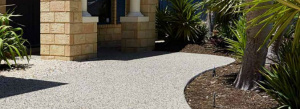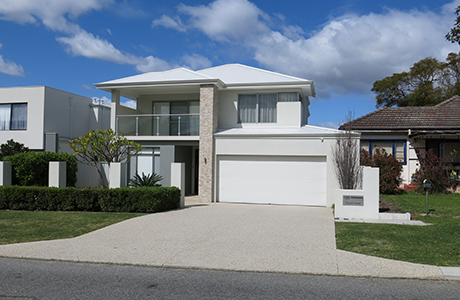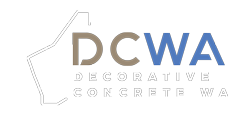Increasing Your Property Value With Decorative Concrete
- May 27, 2019
- Written By Brad Russell
- Benefits of Decorative Concrete
The Early History of Decorative Concrete
In the 1950s, a California contractor named Brad Bowman began experimenting with etched designs on concrete, which he termed ‘ornamental concrete.’ His innovations laid the foundation for modern decorative concrete techniques. Bowman created a wheel-shaped metal device that could be rolled over recently poured concrete. The result was a pattern that was laid into the concrete.
 After successfully mastering the technique, Bowman then began to add coloured additives to the concrete as well, and “Decorative Concrete” was born.
After successfully mastering the technique, Bowman then began to add coloured additives to the concrete as well, and “Decorative Concrete” was born.
In the 1970s, John Nasvick advanced Bowman’s work by creating a lighter, urethane stamp that added both patterns and texture. His innovation gained attention when Walt Disney’s Epcot Centre used it for over a dozen footpath designs, marking a significant milestone for decorative concrete in commercial projects.
Meanwhile, many outdoor landscape designers had been using decorative aggregate stone-concrete decks around high-end swimming pools in Beverly Hills and other swanky LA homes for years, and together with the patterned stamp on driveways, new industries were formed world-wide.
Why Should a Homeowner Consider Decorative Concrete?
There are many reasons why a homeowner would consider decorative concrete for their home. Among them are:
- Environmentally friendly
- Safe for pets
- Easy to maintain
- Relatively slip-proof
- Wards off water
- Homeowners will avoid cracks that form on ordinary or asphalt driveways
- Looks great and enhances the curb appeal of your house
- Increases the value of your home
For the purpose of this article, we’ll concentrate on two of these elements; curb appeal and increased value to your home.
1.) Curb Appeal
 If there ever comes a time when you wish to sell your house, any reputable real estate agent will tell you that having a house with great curb appeal is essential.
If there ever comes a time when you wish to sell your house, any reputable real estate agent will tell you that having a house with great curb appeal is essential.
When a prospective buyer pulls up in front of your home, they will make a value judgment within seconds as to whether this is a great house for them or not.
For example, a recent study by the University of Western Australia discovered that a broad-leaved tree on the street verge increases the median property price by about $16,889. If a single tree can do that, imagine the impact a stunning exposed aggregate driveway can make?
Of course, you want to have a house that is freshly painted and has a well-manicured lawn, but if your driveway is cracked, has oil stains, or just looks vanilla plain, your curb appeal for your house goes way down.
2.) The Value of Your House
Associated with curb appeal, but closer to your bottom line is your home’s value. Of course there are many factors here, but a house with a decorative concrete driveway can be worth as much as 10% more on the open market.
And with Perth homes averaging in the vicinity of half a million dollars, that means a single, enhanced driveway could increase the value of your home by $25,000-$50,000 (or more).
Outside of a coat of paint, enhancing the look of your driveway can be among your best investments.
What are the Differences?
Outside of patterns and textures, the singular elements of decorative concrete are the type of stone aggregate used, and the staining elements of the concrete.
Exposed Aggregate Concrete
The most popular type of decorative concrete is called exposed aggregate concrete. Concrete is made by mixing water, cement and aggregate.
Once mixed, traditional concrete is smoothed out and left to harden. Exposed aggregate concrete takes an extra step. The concrete is poured like normal, but then the surface layer of concrete is removed, revealing the stone aggregate on top.
The old fashioned way of removing the top layer to reveal the underlying aggregate was to either use brushes or water hoses. Today, contractors primarily pour the concrete and then use special retardant sprays to finish the concrete surface after pouring it.
These special retardants delay the time the concrete hardens, and allow a contractor to remove the surface level of concrete for as long as 24-hours after pouring.
Polished Exposed Concrete
Fundamentally, the two concrete batches are made the same way, with the exception that the with polished exposed concrete, the aggregate is ground up several times, and then polished to a bright sheen.
What Kind of Colours and Textures Can Be Created?
The sheer brilliance of aggregate concrete is that it can be stained, coloured and shaded in a huge myriad of colours, patterns and textures.
For example, we offer nearly three dozen varieties of decorative concrete in such shades as:
- Black pepper
- Crystal
- Night sky
- Salt and pepper
- White rose
- Amber white
- Amber grey
- White ash
- Coral
- And many more!

And the best part of aggregate concrete is that it can be custom mixed and matched to offer you a plethora of design possibilities.
A driveway, for example, composed of exposed aggregate stone, may be inlaid with diamond “tiles” of an opposing colour to make a stunning, patterned driveway or swimming pool deck area.
Polished Decorative Floors
When it comes to flooring, the idea of decorative concrete doesn’t immediately come to mind for most homeowners, although the restaurants they eat at, and the places they work at may indeed use concrete decorative flooring.
But there are several reasons why polished, decorative flooring makes sense:
- Decorative concrete costs are considerably lower than wood
- It’s very low maintenance, particularly when compared to solid hardwood flooring
- It gives off no harmful chemicals, which even the best carpeting can do
- It will not trap allergens
- The surfaces are stain resistant
A Few Questions and Answers
Q: Will decorative concrete driveways crack?
A: Contractors do their best to prevent cracking by establishing joints within your driveway to relieve pressure and mix concrete and rebar to make a solid, long-lasting product. Yet, concrete, of any kind can develop small cracks over several years of outdoor sun followed by night-time cooler temperatures. However, if your driveway should crack, it will generally be minimal, and cracks can be repaired.
Q. Will my driveway or pool deck need a sealant?
A. Decorative concrete is a highly durable and sustainable material. To maintain its appearance and longevity, it’s recommended to apply a sealant every 3-5 years, particularly for areas exposed to harsh weather or heavy foot traffic.
Q. Will the colour of outdoor decorative concrete fade?
A. The colour of decorative concrete is embedded into the material, ensuring long-term vibrancy. While prolonged UV exposure can cause slight fading, this can be revitalised with regular applications of sealant.
Q. Will my driveway, pool deck or floor be slippery?
A. When installing decorative concrete flooring, pool decks or driveways, contractors will include a polymer grit to the mix, insuring that the surface is easy to walk on.
Q. Is decorative concrete expensive?
A. Installing decorative concrete on driveways and pool decks typically takes twice as long as standard concrete due to the additional design work and materials. However, the initial investment is offset by its durability and the potential to increase home value.
Q.How long will a project take?
A. Not counting lead time, once a project commences, it normally takes one day of setup followed by two days to pour your concrete.
Q. How long till I can walk or drive on my walkway or driveway?
A. You can normally walk on a project within 12 hours. However, for driveways, it is recommended you allow 7 days of cure time.
Q. Can you match the colour of a house?
A. While no contractor can guarantee to match the colour of your house, the variety of colours and textures available will ensure that you have a complementary colour to your home’s paint colour.
